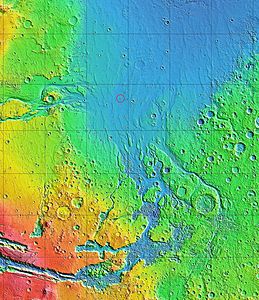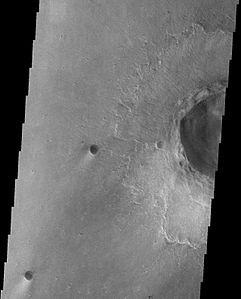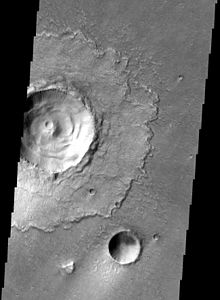Lismore (Mars crater)
Lismore is a by the same name in Southern Ireland named in September 2006 Mars crater in Chryse Planitia near the southern outlet channel which Tiu Valles in degree field Oxia Palus (MC-11). The crater has a diameter of 9.32 km and is 318.37 long east and 27.048 north latitude. The rock in the crater floor is partially exposed.
Lismore is one of the numerous craters in the region that are of particular interest for research, as they have remained largely untouched since their formation due to their low age and the layer of dust covering them is comparatively thin. With the help of the THEMIS instrument from 2001 Mars Odyssey , the infrared radiation of the Mars surface could be measured, which enables conclusions to be drawn about the type of material on the surface, especially by comparing day and night images . Further measurements were made possible due to the TES instrument of the Mars Global Surveyor and the CRISM instrument of the Mars Reconnaissance Orbiter . Here the ejecta of young craters such as Lismore serve as measurable samples of the otherwise hidden rock. On the basis of these recordings it was determined that the ejecta cover of the Lismore crater, which extends over an area of more than 355 km², differs significantly in composition from the surrounding area and consists of only one very uniform layer interspersed with mafic minerals , the coarser one Materials on the crater rim and the finer materials further out on the periphery of the ceiling. Likewise, let Olivine and in a lesser extent clinopyroxene evidence in the ejecta blanket. Several researchers see it as evidence that there is basaltic rock from the Hesperian period under the surface in Chryse Planitia .
See also
literature
- John K. Harmon: Radar Imagery of the Chryse-Xanthe Region, Mars. 2013, accessed July 31, 2016 .
- Eriita Jones, Graziella Caprarelli, Gordon R. Osinski: Insights into complex layered ejecta emplacement and subsurface stratigraphy in Chryse Planitia, Mars, through an analysis of THEMIS brightness temperature data . In: Journal of Geophysical Research: Planets . tape 121 , no. 6 , 2016, p. 986-1015 , doi : 10.1002 / 2015JE004879 .
- Cong Pan and A. Deanne: Thermally and compositionally distinct crater ejecta on Mars and geological implications. In: 47th Lunar and Planetary Science Conference. 2016, accessed August 6, 2016 .
- Mark R. Salvatore, John F. Mustard, Michael B. Wyatt, Scott L. Murchie: Definitive evidence of Hesperian basalt in Acidalia and Chryse planitiae . In: Journal of Geophysical Research: Planets . tape 115 , E7, July 2010, doi : 10.1029 / 2009JE003519 .
Web links
Individual evidence
- ↑ Lismore. In: Gazetteer of Planetary Nomenclature. Retrieved July 31, 2016 . Names Approved for 31 Craters on Mars. September 20, 2006, accessed July 31, 2016 .
- ↑ Eriita Jones et al. 2016, p. 994
- ^ Mark R. Salvatore et al. 2010, p. 9.
- ↑ Eriita Jones et al. 2016, p. 990; Mark R. Salvatore et al. 2010, p. 9; Lismore Crater. July 17, 2012, accessed July 31, 2016 .
- ↑ Eriita Jones et al. 2016, p. 1002; John K. Harmon, 2016; Mark R. Salvatore et al. 2010, p. 9; Cong Pan and A. Deanne 2016.
- ^ Mark R. Salvatore et al. 2010, p. 9; Cong Pan and A. Deanne 2016.
- ^ Mark R. Salvatore et al. 2010, p. 11; Cong Pan and A. Deanne 2016.


